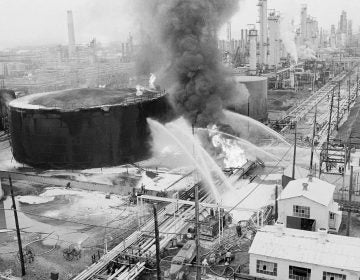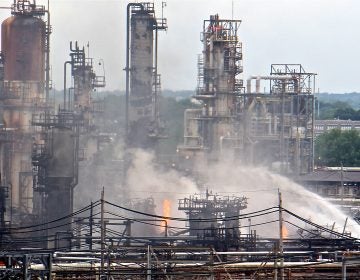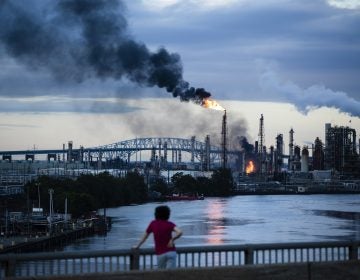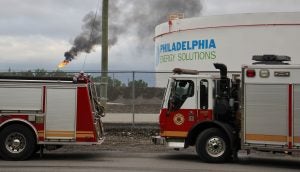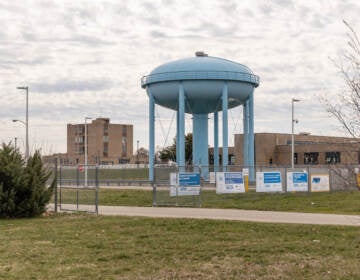City to convene safety working group after massive South Philly refinery fire
Mayor Jim Kenney has convened a working group to examine safety and air quality protocols at the South Philadelphia refinery rocked by a massive explosion on Friday.
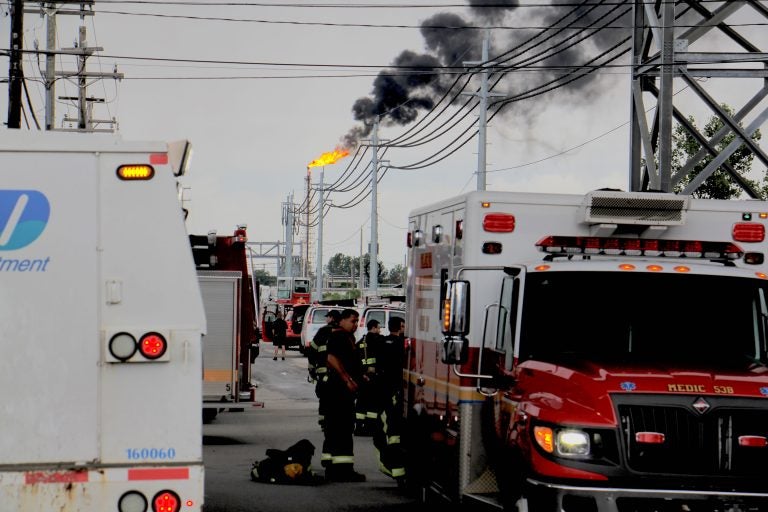
At the scene from a fire staging area under the Platt Bridge, a flare can be seen burned off fuel (Emma Lee/WHYY)
Mayor Jim Kenney has convened a working group to examine safety and air quality protocols at the South Philadelphia refinery rocked by a massive explosion on Friday. It was the second refinery fire in two weeks.
Kenney said in a release sent Friday that the working group would explore longtime concerns from people who live near the Philadelphia Energy Solutions refinery at 3100 W. Passyunk Ave.
“I believe that there is room for improvement, both in the operation of the refinery in light of two fires in as many weeks, and in the communication to residents,” Kenney said.
He said that the working group will involve Managing Director Brian Abernathy, Fire Commissioner Adam Thiel, the leadership of PES, and unnamed members of the company’s Community Advisory Panel.
The mayor said that questions about air quality will be a particular focus of the working group. PES did not respond to questions about potential air pollution hazards.
The fire broke out at 4:00 a.m. on Friday and continues to burn. A mix of propane and butane continue to feed the flames at the refinery. The fire still has not been put out, but it is “confined and contained,” Deputy Fire Commissioner Craig Murphy said Friday afternoon. Health Department tests done Friday found no hazards in the air, city officials said.
At 6:00 am, two hours after the fire began to burn, phone alerts were sent out to some area residents warning them to “shelter-in-place.” An hour later, the all clear was sounded.
Mayor Jim Kenney praised the “speedy and effective” response to the blaze and said that the “shelter-in-place notifications” were sent out with adequate speed.
He stated in a Friday afternoon release that the two explosions this month are “unrelated in their nature and cause.”
But he said that he is well aware of neighborhood concerns about the safety of the refinery, which is the subject of frequent protests.
The refinery is the largest on the East Coast and one of the 10 largest in North America. The company that operates it, Philadelphia Energy Solutions (PES), is in financial turmoil even after it exited bankruptcy earlier this year.
Public health advocates said the working group is a step in the right direction but long overdue.
“It’s a task force that should have been created a long time ago,” said Joseph Otis Minott, Executive Director and Chief Counsel of Clean Air Council. “It is an old plant being run by a company that is essentially bankrupt and has a long history of being non-compliant. It is past time for the city to consider whether it is safe for a facility like this to be operating so close to where people live.”
The Clean Air Council applauded an announcement Friday of an impending investigation into the fire by the U.S. Chemical Safety and Hazard Investigation Board.
“Clean Air Council applauds the swift action of the Chemical Safety Board in deploying an investigation team to the refinery,” Minott said. “We look forward to a full airing of the facts so we can stop this kind of dangerous situation from threatening the safety of Philadelphia residents again.”
The federal inspectors have not scheduled their investigation.
City Councilwoman Helen Gym called for the city to take steps towards considering a redevelopment of the massive complex. Councilman Kenyatta Johnson, who represents the area where the refinery is located, said PES needs to be “held accountable” after the two fires.
The most scathing criticism of the PES and the city’s response to the explosion came from Fred Millar, an independent expert on public safety and hazardous materials.
Millar said that the city should have evacuated South Philadelphia after explosions ripped through the facility. He said that the refinery uses highly toxic hydrofluoric acid to make gasoline and that there was a danger of the explosions rupturing the storage tank.
There is no indication that the chemical was released in Friday’s fire. A similar series of explosions in a refinery in Superior, Wisconsin, forced an evacuation of that 26,000 person city last year even though hydrofluoric acid was not released in that case either.
Millar said a similar evacuation should have been called in South Philadelphia, noting that the toxic cloud from hydrofluoric acid can grow to as much as 10 miles in length. The chemical can cause serious health issues and even death.
“A hydrofluoride refinery is about the most dangerous facility anyone could have in the community,” said Millar. “The hydrofluoride tank can produce an enormously dangerously toxic gas cloud. Depending on which way the wind was blowing, unless it was blowing straight up to heaven, the city should have called a precautionary evacuation.”
PES and a mayoral spokesperson did not immediately respond to requests for comment on Millar’s concerns.
WHYY is your source for fact-based, in-depth journalism and information. As a nonprofit organization, we rely on financial support from readers like you. Please give today.



